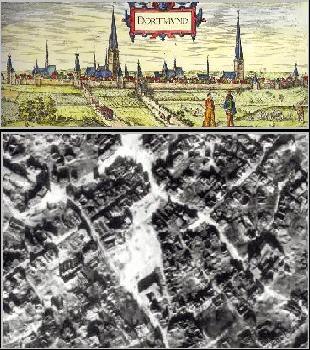

The third large-scale attack on May 23, 1944 was applied methodically to the residential areas in the south, southeast and the east of the city. On the evening October 6, 1944, a fourth large-scale attack left 60,000 more people shelterless and 1,015 dead in 40 minutes. High-explosive bomb attacks now started to increase. The most terrible attack took place on March 12, 1945 when 1,069 bombers dropped nearly 5,000 tons of explosives over Dortmund. For 43 minutes, the earth trembled and the buildings and homes could be heard creaking and collapsing all around, while the smoke clouds finally seeped into the cellars and shelters, choking the terrified people huddling in the cold, dark holes filling with groundwater.
Civil records estimated 6,341 deaths by the bombing. 70% of all dwellings were destroyed, as was the entire historic town center and the residential area where in former times about a quarter of a million humans lived. Rubble and broken roads blocked traffic. Water, gas and electric supply lines were gone, and the drainage system inoperable. The once beautiful Hanseatic city filled with romantic Gothic churches and monuments was gone. The majority of the inhabitants lost homes and property and were soon hungry and freezing in miserable emergency accommodation. 15,520 of their sons, fathers and husbands were soldiers that never came home.